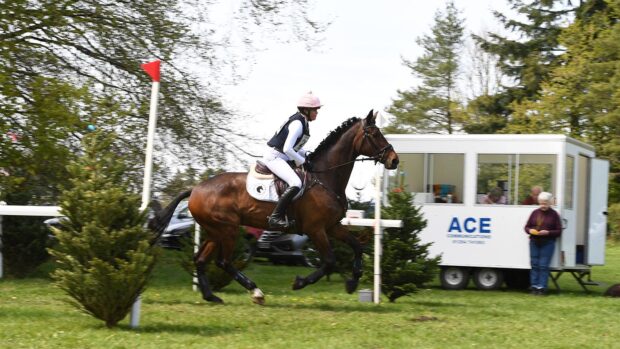You know the feeling; your horse starts to drop behind your leg, he is not quite giving his fences enough clearance and his breathing rate increases. The chances are he is fatigued. His ability to continue performing is compromised because a protective mechanism has kicked in to prevent him exercising to a point where he may cause himself actual damage.
As a fight or flight animal, the horse may be willing to go further than a human athlete in terms of combating fatigue. This is because during hard exercise a horse’s adrenalin level is around 10 times higher than our own. Adrenaline can help mask pain and allow a horse to push itself harder than may be beneficial to its welfare. For this reason, it is important that we recognise the signs of fatigue and know how to delay its onset through appropriate riding.
As Paul Farrington, a vet for the FEI (horsesport’s international governing body) says: “Riders must take the lead in recognising the signs of over-fatigue and stop to save their horse from potentially serious injury before it occurs.”
What is fatigue?
Fatigue may manifest itself in different ways depending on what it is we are asking of the horse (see panel, far right). It is different from exhaustion, which can result in an inability for a horse even to take another step.
In general terms, the harder a horse works, the earlier it will fatigue: horses at the end of a five-furlong Flat race that lasts less than a minute will be fatiguing, as will endurance horses at the end of a 160km race lasting 10 hours. But the underlying causes will be very different.
Damage limitation
If a horse is struggling to maintain the level of intensity of exercise a rider is asking, a warning mechanism will be triggered and the horse will start to tire.
Fatigue is not an all or nothing event — it tends to creep up. It is important that the rider takes the pressure off at this point because continuing to press a tired horse will increase the risk of injury.
A fatigued horse is more likely to stumble and suffer tendon damage, while a horse that has been pushed beyond the point of fatigue in training or competition runs the risk of developing other conditions after exercise, such as colic, tying-up, laminitis or heat exhaustion.
What causes fatigue?
Fatigue can occur either in the brain, the peripheral nervous system, or more commonly in the muscles themselves. In the latter case, the brain sends the correct signals for what it wants to happen, but the muscles cannot deliver.
It is important to remember that as well as locomotion — running and jumping — muscles, other muscles are also important for exercise. Fatigue of muscles in the upper airway, for example, may also result in reduced capacity for exercise.
Precisely what causes muscle fatigue is still not fully understood, but it can involve the depletion of energy stores, the accumulation of metabolic end-products such as lactic acid and the failure of contractile machinery, which may be the result of calcium imbalance. Electrolyte loss through disturbances to the internal environment of the muscle cells is also thought to be a contributing factor.
When the brain takes over
Central fatigue is different. This refers to processes in the brain where the muscles may have the capacity to exercise, but the brain overrides this and makes the horse slow down.
Central fatigue can be due to a variety of factors, such as low blood-sugar levels, hormones in the blood and pain. Sensations of breathlessness can also trigger central fatigue; horses with an upper airway obstruction such as roaring or a lower airway problem such as recurrent airway obstruction (RAO), may also be more susceptible.
Think fitness
Many different factors influence how quickly a horse fatigues. These include: speed, duration of exercise, the going, terrain, athletic ability, age, fitness and overall health, plus environmental conditions such as heat and humidity.
Of these factors, the one we can most heavily influence is fitness. As we train our horses and make them fitter, they become less prone to tiredness. It will still occur, but the horse will be able to exercise for longer without tiring.
So how can we reduce the chances of early fatigue?
Aside from training and fitness work, appropriate warm-up is also important. This should involve a period of exercise incorporating similar movements at a similar intensity to those that will be performed in competition. For example, a showjumper’s warm-up should include some work over small fences as well as the size of those to be jumped in the ring, while an event horse needs both faster canter work and jumping included in his prep.
Too little, or too much, warm-up could compromise your horse’s health — and your chances of success. Aim to finish warming-up five to 10 minutes before you compete.
Continued below…

7 jumping questions you thought were too obvious to ask
There are some jumping questions that seem too

5 clipping challenges you need to prepare yourself for…
The signs to look out for
Fatigue can manifest itself in a variety of ways according to discipline, but signs to watch out for are:
➤ A slowing of pace
➤ Decreased responsiveness to the aids
➤ An unwillingness or inability to increase speed or change gait
➤ Loss of motivation
➤ Reduced coordination (for example, stumbling/losing balance/wandering)
➤ Increased frequency of brushing or overreaching
➤ Increased frequency of changes in lead in canter and gallop
➤ Increased head and neck movement
➤ Increased breathing effort
➤ Hitting obstacles
This article was first published in Horse & Hound Ask The Vet (Spring 2012)



